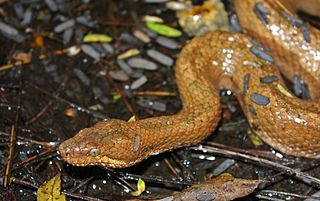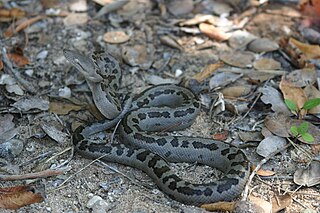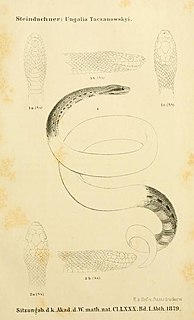
Chilabothrus exsul is a nonvenomous boa species found in the Bahamas. No subspecies are currently recognized.

The Tropidophiidae, common name dwarf boas or thunder snakes, are a family of nonvenomous snakes found from Mexico and the West Indies south to southeastern Brazil. These are small to medium-sized fossorial snakes, some with beautiful and striking color patterns. Currently, two living genera, containing 34 species, are recognized. Two other genera were once considered to be tropidophiids but are now known to be more closely related to boids, and are classified in the subfamily Ungaliophiinae. There are a relatively large number of fossil snakes that have been described as tropidophiids, but which of these are more closely related to Tropidophis and Trachyboa and which are more closely related to Ungaliophis and Exiliboa is unknown.

Tropidophis melanurus, commonly known as dusky dwarf boa, Cuban wood snake, or Cuban giant dwarf boa, is a non-venomous dwarf boa species found mainly in Cuba. Currently, there are three subspecies recognized, including the typical form described here.

Tropidophis, common name wood snakes or West Indian wood snakes, is a genus of dwarf boas endemic to the West Indies and South America. Currently, 17 species are recognized.
Tropidophis fuscus is a non-venomous dwarf boa species found in Cuba. No subspecies are currently recognized.
Tropidophis bucculentus, the Navassa Island dwarf boa, was a nonvenomous dwarf boa species endemic to Navassa Island. No subspecies are currently recognized.

Corallus cookii, also known as Cook's tree boa or Cooke's tree boa, is a species of nonvenomous snake in the family Boidae. The species is endemic to the island of St. Vincent in the Caribbean. There are no recognized subspecies.

Ambergris Cay, also known as Big Ambergris Cay, is a private residential island located within the Turks and Caicos Islands. Not to be confused with Ambergris Caye in Belize, Ambergris Cay is situated to the southeast of the main chain of the Caicos islands. Adjacent to Ambergris Cay is Little Ambergris Cay, which is an uninhabited natural reserve. Little Ambergris Cay is a unique and significant habitat for a wide range of birds and marine life. Ambergris Cay island is approximately four miles long, one mile wide, and 1,100 acres (4.5 km2) in total.
Leiocephalus greenwayi, commonly known as the East Plana curlytail or Plana Cay curlytail lizard, is a species of lizard in the family of curly-tailed lizard (Leiocephalidae).

Chilabothrus chrysogaster, commonly known as the Turks Island boa or the Southern Bahamas boa, is a species of snake found in the Southern Bahamas and the Turks and Caicos Islands. Local names include rainbow boa, Bahamas cat boa, rainbow snake, and fowl snake. Like all boids, it is not a venomous species.
The Bahamian pygmy boa constrictor, Inagua trope, or Bahama wood snake is a species of nonvenomous snake in the family Tropidophiidae. The species is endemic to the Great Inagua Island, the Bahamas.
Tropidophis battersbyi, also known commonly as Battersby's dwarf boa and the Ecuadorian dwarf boa, is a species of snake in the family Tropidophiidae. The species is endemic to Ecuador.

Tropidophis feicki, also known as the broad-banded dwarf boa or Feick's dwarf boa, is a species of snake in the family Tropidophiidae. The species is endemic to Cuba.
Tropidophis nigriventis, or the black-bellied dwarf boa, is a species of snake in the family Tropidophiidae. The species is endemic to Cuba.
Tropidophis pardalis, or the leopard dwarf boa or spotted brown trope, is a species of snake in the family Tropidophiidae. It is endemic to Cuba.
Tropidophis pilsbryi, commonly known as Pilsbry's dwarf boa or the Cuban white-necked dwarf boa, is a species of snake in the family Tropidophiidae. The species is endemic to Cuba.

Tropidophis taczanowskyi, also known commonly as Taczanowski's dwarf boa, is a species of snake in the family Tropidophiidae. The species is native to northern South America.
Tropidophis wrighti, commonly known as the gracile banded dwarf boa, the gracile banded trope, and Wright's dwarf boa, is a species of snake in the family Tropidophiidae. The species is endemic to Cuba.
Albert Schwartz was an American zoologist who worked extensively with the herpetofauna of Florida and the West Indies, and later with butterflies. One magazine article once dubbed him as one of the "Kings of West Indian Anole Taxonomy".







